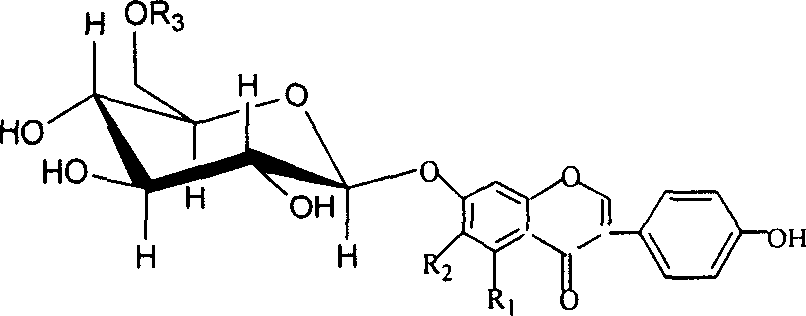Method for enzyme hydrolysis of soybean isoflavone for producing genistein and daidzin aglycon
A technology of soybean isoflavones and genistein, applied in the direction of fermentation, etc., can solve the problems of unsafe conditions, difficult strong acid conditions, and many by-products of strong acid hydrolysis, and achieve the effects of product safety, easy operation, and reduced production costs
- Summary
- Abstract
- Description
- Claims
- Application Information
AI Technical Summary
Problems solved by technology
Method used
Image
Examples
Embodiment 1
[0036] Example 1 Preparation of soybean β-glucosidase and hydrolysis of soybean soybean isoflavones
[0037] 500.0 g of whole soybeans (No. Dongnong No. 42, provided by the Soybean Research Institute of Northeast Agricultural University) were soaked in water at 20° C. for 20 hours, and rinsed with cold water. Add 0.1mol·L to soaked soybeans -1 , pH 6.60 phosphate buffer solution 5000mL, electric homogenizer homogenization. Soymilk was centrifuged at 4000 rpm for 3 min. Supernatant with 0.1mol·L -1 acidified with HCl to pH 5.0, and centrifuged for 10 min at 4°C in an automatic refrigerated centrifuge at 8000 r / min. The supernatant obtained is the crude enzyme. Add ammonium sulfate to the crude enzyme to make the saturation reach 75%, and let stand for 20 hours. 8000r / min, 4°C, refrigerated and centrifuged for 10min, collected precipitated protein, dissolved in 0.05mol·L -1 , pH 5.0 in disodium hydrogen phosphate-citric acid buffer solution. Pour the enzyme solution into ...
Embodiment 2
[0039] Example 2 Reesei Trigerase β-glucosidase (commercial enzyme fermented by Reesei Trigerase to obtain cellulase, extracted and purified from cellulase to obtain β-glucosidase) hydrolyzes soybean isoflavone powder to prepare genistein and Daidzein
[0040] Get 100g 20% soybean isoflavone powder (provided by Heilongjiang Grain Research Institute), add disodium hydrogen phosphate-citric acid buffer solution to adjust pH to 4.5, add β-glucosidase (β-glucosidase (β The specific activity of a glucosidase is: 230,000 U / g), and it is hydrolyzed by shaking in a water bath at 50°C for 90 minutes. Then centrifuge and filter to separate, and the separated soy isoflavone aglycone precipitate is washed with water (the water volume is 4 / 5 of the original liquid) at 70° C. for 30 minutes, and left overnight. Centrifugal filtration and separation, the obtained precipitate was washed with water (the volume of water was 4 / 5 of the original liquid) at 70°C for 15 minutes, centrifugal filt...
Embodiment 3
[0041] Example 3 Method for preparing high-content genistein and daidzein
[0042] If it is necessary to prepare high-content genistein and daidzein, high-purity soybean isoflavone powder can be used as a substrate for hydrolysis. Before hydrolysis, the soybean isoflavone powder is further purified, and then hydrolyzed. The specific method is as follows:
[0043] Accurately weigh soybean isoflavone powder, add leaching agent acetone at a ratio of 1:20, heat, stir and reflux for extraction at 60°C for 3h, centrifuge the extract at 4000r / min for 20min, and take the upper layer. The precipitate was extracted again with 1:10 acetone at 60° C. under magnetic heating, stirring and reflux for 1 h, centrifuged, and the two extracts were combined. Acetone was removed by rotary evaporation under reduced pressure. The purified soy isoflavones are used for enzymatic hydrolysis of the substrate, and after hydrolysis according to the above-mentioned optimal enzymatic hydrolysis condition...
PUM
| Property | Measurement | Unit |
|---|---|---|
| Specific vitality | aaaaa | aaaaa |
Abstract
Description
Claims
Application Information
 Login to View More
Login to View More - R&D
- Intellectual Property
- Life Sciences
- Materials
- Tech Scout
- Unparalleled Data Quality
- Higher Quality Content
- 60% Fewer Hallucinations
Browse by: Latest US Patents, China's latest patents, Technical Efficacy Thesaurus, Application Domain, Technology Topic, Popular Technical Reports.
© 2025 PatSnap. All rights reserved.Legal|Privacy policy|Modern Slavery Act Transparency Statement|Sitemap|About US| Contact US: help@patsnap.com



